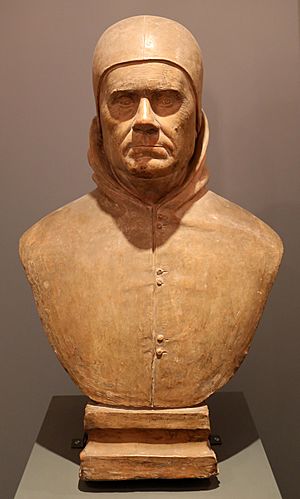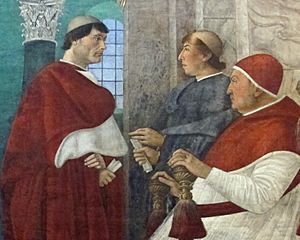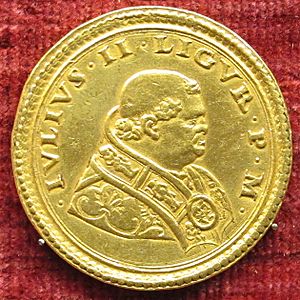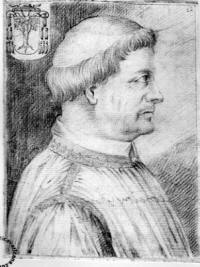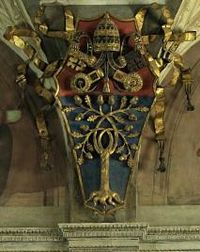Pope Julius II facts for kids
Quick facts for kids Pope Julius II |
|
|---|---|
| Bishop of Rome | |

Portrait by Raphael, 1511–1512
|
|
| Church | Catholic Church |
| Papacy began | 1 November 1503 |
| Papacy ended | 21 February 1513 |
| Predecessor | Pius III |
| Successor | Leo X |
| Orders | |
| Ordination | 1471 |
| Consecration | 1481 (?) by Sixtus IV |
| Created Cardinal | 15 December 1471 |
| Personal details | |
| Birth name | Giuliano della Rovere |
| Born | 5 December 1443 Albisola, Republic of Genoa |
| Died | 21 February 1513 (aged 69) Rome, Papal States |
| Buried | St. Peter's Basilica, Rome |
| Parents | Raffaello della Rovere and Theodora Manerola |
| Children | Felice della Rovere |
| Previous post |
|
| Coat of arms |  |
| Other Popes named Julius | |
Pope Julius II (born Giuliano della Rovere; 5 December 1443 – 21 February 1513) was the leader of the Catholic Church. He also ruled the Papal States (a group of territories in Italy) from 1503 until his death in 1513. People called him the Warrior Pope or the Fearsome Pope because he was very active in military and political matters. He chose the name Julius not after an earlier pope, but after the Roman leader Julius Caesar.
Julius II was one of the most powerful popes of his time. He played a big role in the High Renaissance, a period of great art and culture. His actions helped the Papal States become stronger. The Pope's role remained very important in Italy and Europe throughout the 1500s.
In 1506, Pope Julius II started the Vatican Museums, which are famous art museums today. He also began rebuilding St. Peter's Basilica, a very important church. In the same year, he created the Swiss Guards to protect the Pope. He also led a successful military campaign in Romagna, a region in Italy. Julius II was also interested in the New World. He approved the Treaty of Tordesillas, which divided new lands between Spain and Portugal. He also helped set up the first Catholic churches in the Americas. In 1508, he asked Raphael to paint the Raphael Rooms and Michelangelo to paint the Sistine Chapel ceiling.
Contents
Pope Julius II: A Powerful Leader
Julius II became Pope during a time called the Italian Wars. This was when powerful European countries fought for control over Italy. France controlled Milan, and Spain ruled Naples. The Holy Roman Emperor, Maximilian I, also wanted to be involved in Italy.
When Julius II became Pope, he had a clear goal. He wanted to make the Papal States stronger and unite them. He also wanted to "free Italy from the barbarians," meaning he wanted to remove foreign armies from Italian lands.
In his early years as Pope, Julius II removed the powerful Borja family from their influence in the Papal States. He also joined a group called the League of Cambrai. This group included France, Spain, and Austria. Their goal was to take land from the Republic of Venice.
After achieving this, Julius II formed a new group called the "Holy League" with Venice. This time, their goal was to push the French out of Italy. He even led the Papal army himself in some battles, like the Siege of Mirandola. Eventually, the French troops had to leave Italy.
By 1512, Julius II had helped restore Italian families to power in different cities. The Papal States also gained new territories. He worked to make the Church the main power in the Italian Wars. At the end of his time as Pope, he was seen as the "liberator of Italy."
Julius II had plans for a new crusade against the Ottoman Empire. However, he died before he could make it happen.
Early Life and Cardinal Years
Giuliano della Rovere was born in 1443 near Savona, in the Republic of Genoa. His family, the della Rovere, was noble but not very rich. His uncle, Francesco della Rovere, was a Franciscan friar. He took young Giuliano under his care and sent him to study in Perugia.
Giuliano's uncle later became Pope Sixtus IV. In 1471, his uncle made Giuliano a cardinal. This was a common practice at the time, where popes would give important positions to their relatives. As a cardinal, Giuliano held several important church offices.
He traveled a lot as a papal representative. He went to France to help make peace between kings and raise money for wars. He also helped negotiate the release of imprisoned cardinals.
In 1483, Giuliano had a daughter named Felice della Rovere.
After Pope Sixtus IV died, Giuliano della Rovere became a very important advisor to the new Pope, Pope Innocent VIII. He was involved in political events, including a conflict with the Kingdom of Naples.
Becoming Pope
After Pope Innocent VIII died, there was an election for the new Pope in 1492. Cardinal della Rovere was a strong candidate. However, Rodrigo Borgia was elected instead, becoming Pope Alexander VI. Della Rovere was very unhappy about this.
He left Rome and joined Charles VIII of France. Charles VIII wanted to take control of Italy by military force. Della Rovere hoped this would help him against Pope Alexander VI. Charles VIII's army entered Rome, but his plans in Italy did not last.
Later, after Charles VIII died, Della Rovere tried to improve his relationship with the Borgia family. He was involved in negotiations for marriages between royal families.
In 1503, Pope Alexander VI died. Another election was held. This time, Giuliano della Rovere was elected Pope on November 1, 1503. He became Pope Julius II. People believed he won the election through promises and gifts.
A Renaissance Pope: Art and Power
Pope Julius II wanted to make the Papal States strong and independent. He worked to remove the Borgia family's influence. He also helped bring peace between two powerful Roman families, the Orsini and Colonna.
He wanted to take back towns that Venice had taken after Pope Alexander's death. He formed alliances with France and the Holy Roman Empire against Venice. In 1506, he personally led an army to free Perugia and Bologna from their rulers.
In 1503, Julius II allowed Henry VIII of England to marry Catherine of Aragon. This decision would become very important later in history.
In 1506, Pope Julius II founded the Swiss Guard. This group of soldiers still protects the Pope today. He saw himself as a powerful leader, like an emperor, who could lead a Christian empire. He wanted to "drive out the barbarians" from Italy.
The League of Cambrai and Holy League
Julius II was very active in military matters. He led his troops into battle more than once. In 1508, he formed the League of Cambrai with France, the Holy Roman Emperor, and Spain. This group fought against the Republic of Venice. Julius wanted to regain control of lands in Romagna. In 1509, his troops won a big battle against Venice.
The alliances kept changing during these wars. Venice and France switched sides. By 1511, Julius II formed a new "Holy League" with Spain, Venice, and England against France. He saw France as the main foreign power threatening the Papal States.
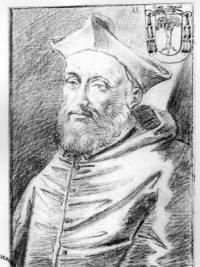
Even after a big battle where many soldiers died, Julius II continued to fight. He hired Swiss soldiers to fight the French in Milan. This forced the French army to leave Italy. The Papacy gained control of more lands in central Italy. Julius II wanted to create an independent Italian kingdom, but this dream was not fully achieved.
Lateran Council
In 1512, Pope Julius II called a major church meeting called the Fifth Council of the Lateran. He had promised to do this when he was elected. This council was important because it helped strengthen the Pope's authority. Julius II also used this council to make rules against buying and selling church positions, which was a problem at the time. He wanted to make sure these rules were followed even after his death.
Death and Legacy
Pope Julius II became very ill in late 1512. He knew his health was failing. He died on the night of February 20–21, 1513, from a fever.
Even though Michelangelo's famous "Tomb of Julius" is in a church called San Pietro in Vincoli, Julius II is actually buried in the Vatican. His remains are near his uncle, Pope Sixtus IV, in St. Peter's Basilica. A simple marble stone marks their resting place. Pope Leo X became the next Pope after Julius II.
Patron of the Arts
Beyond his military and political achievements, Pope Julius II is famous for supporting art, architecture, and literature. He did a lot to improve and beautify the city of Rome.
He decided to rebuild the old St. Peter's Basilica, which was very old and falling apart. He chose the architect Donato Bramante for this huge project. On April 18, 1506, Pope Julius II laid the first stone of the new St. Peter's Basilica.
He was a friend and supporter of Bramante and Raphael, and a patron of Michelangelo. Many of Michelangelo's greatest works, like the paintings on the ceiling of the Sistine Chapel, were ordered by Julius II. He also commissioned two new streets in Rome to help with the city's renewal.
Appearance
Julius II is often shown with a beard in paintings, like the famous portrait by Raphael. However, the Pope only wore his beard for a short time, from 1511 to 1512. He grew it as a sign of sadness after losing the city of Bologna. He was the first Pope in a long time to have facial hair, as it was usually not allowed. He shaved his beard before he died.
Depiction in Culture
- Julius II appears in The Prince by Niccolò Machiavelli. Machiavelli describes him as a strong leader who knew how to use power.
- In the 1965 film The Agony and the Ecstasy, which is about Michelangelo's life, Julius II is played by Rex Harrison.
- Pope Julius II has also been portrayed in several TV series about the Borgia family.
See also
 In Spanish: Julio II para niños
In Spanish: Julio II para niños
- Art patronage of Julius II
- Cardinals created by Julius II


